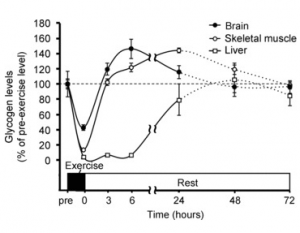These workouts will burn fat for 24 hours
If you want to burn fat efficiently you must exercise.
This article will provide you with two workouts that will not only burn fat during exercise, but also long after you have stopped.
Science suggest that in general, the higher your intensity, the higher your post-workout calorie burn will be. But, and this is one thing most people don’t mention, duration also counts.
You may have heard opinions or statements when comparing different training protocols such as long slow cardio cardio burns more calories during, but less afterwards than high intensity interval training.
Unfortunately this is just another example of what happens in the fitness industry all too often. Statements like these are the result of “gurus” comparing one mode against each other.
I have read many discussions about which mode works best for burning calories after the workout. These comparisons are usually done between continuous exercise and short high intensity exercise. Or sometimes resistance training are thrown into the debate.
Most of these discussions are, in my opinion, silly. I don’t know why you need to try and convince people one or the other. Maybe it just makes good headlines to say things like HIIT burns more calories than steady cardio.
You may have heard advice like don’t worry about the duration, just focus on the intensity. Like just do one Tabata and you’ll burn a ton of calories afterwards.
Yeah, right. First of all the Tabata protocol has never been studied for it’s weight loss effects. It was designed to see how short, extremely intense interval workouts compare to long, less intense workouts in terms of fitness.
I am not arguing that a Tabata workout isn’t good. It is, and I use variations of it fairly often. Mostly as a finisher or I’d do a few in a row as part of a 60 minute workout. It will burn fat but why write misleading articles by suggesting things that simply aren’t true.
Much can be written about the best type of exercise for fat loss, but the purpose of this article is simply to give you two workouts that are basically guaranteed to burn fat during and after you have stopped working out.
 How do you burn calories after exercise?
How do you burn calories after exercise?
Let me first briefly explain how this work. Any exercise will raise your metabolism, some will do more than others. The after-burn effect, is in effect your post exercise oxygen consumption (EPOC).
Your body wants to return to a state of normal after training. This means it needs to repair and improve itself so that it can better handle the demands of hard exercise next time.
Some studies suggest that your oxygen uptake (EPOC from now on) will be higher for up to 38 hrs.
What is important for us is how much higher EPOC will be and how much fat we will burn after our workout has been completed.
Should we even bother with EPOC?
To focus on hard numbers here is narrow minded. I can’t tell you you’ll burn 100g or 300g of fat after a workout, there are just too many factors involved.
What I do know is that certain workouts work better than others. And the effects can be enormous in the long run. Like I have said earlier, your body wants to recover and to do that, oxygen is used in the processes to restore and adapt your body to the exercises that you have performed.
Post exercise, your body do the following:
- Hormone balancing
- Replenishing of fuel stores
- Cellular repair
- Central nervous system adaptions
- Anabolism
Many people will want to look at numbers and say that the effect of EPOC is so small that you should not bother. And write an article about it.
It seems the writers get a topic, grab some stats and make it the core of their article, without the need to look into the whole picture.
You may have noticed general advice these days from just about every boring mainstream article out there would go something like:
“Julia Jones (CBCC, APT, FFA, WWE and some other acronyms proving she knows what she talking about) from Best Globo Gym in New Hampshire says that you should rather focus on creating a calorie deficit eating a balanced diet consisting mostly of grains, fruit, vegetables, seeds, nuts and leaves, than worry about the afterburn effect.”
I say no. Enough of this nonsense! If more people knew exactly how good working-out is there would be a lot less problems in this world.
It is my self appointed duty to inform you about the benefits of working out effectively. And this include looking into the post-workout calorie burn effect and trying to figure out how much fat you can lose once you have stopped working out.
Just thinking of this magazine style “advice and tips” raises my blood pressure.
For a few seconds.
Okey, I’m composed again. Let’s get on with this article. In order for you to benefit from reading this, I will have to go into a little detail about some aspects.
I promise I won’t turn this into a science lesson, but let’s quickly take a slightly more detailed look at what your body does post workout:
Hormonal changes
This is vital. Positive hormonal changes as a result of exercise will ensure your body handles everything from burning fat for fuel, to storing excess carbohydrate, to staying healthy, better. Healthy hormones means more energy, a more positive outlook and may lower your risk of developing or contracting many diseases.
Replenishing of fuel stores
In response to exercise, fat stores are broken down and free fatty acids are released into the bloodstream. During recovery, free fatty acids are used as fuel. Yes, you are getting leaner post workout.
Another way that exercise helps you stay lean is the way carbohydrate is handled after exercise. Basically if you had a tough workout, the carbs you consume during the recovery phase will go towards replenishing muscle glycogen, rather than fat storage. More glycogen in your muscle means you can train harder next time.
There is off course different factors to consider when using carbs during your weight loss quest. On the one side you should realize that your body will stop using (primarily) fat for energy during recovery as soon as you consume sugar or any other form of simple carbohydrate. Only once all free flowing glucose are cleared will your body return to burning fat for energy.
Don’t let this make you decide not to use carbs after a workout ever. There are many ways to look at it and a lot depend on your training cycle, your immediate goals and your long term goals. Carbs temporarily stop fat burning, but it helps you recover faster and keep your metabolism raised.
The EPOC effect is not influenced by consuming carbs, so that is why it remains important to do the right workouts if you want to take advantage of this.

Repletion of muscle glycogen take precedence over hepatic glycogen repletion post glycogen-depletion exercise. During exhaustive exercise, brain glycogen decrease by 50-60%, while muscle and liver levels decrease by 80-90%.
Glycogen super compensation takes place in the brain (6hrs) and skeleton muscle (24hrs) after exercise.
What does this mean for you? It means that after exhaustive exercise, it is hard for you to gain fat. Instead, fuel from carbohydrates will be used to recover baseline levels first in your brain and muscles, and then in your liver.
To realize how important this is you need to know the function of the liver. The liver is the major site for converting excess carbohydrates and proteins into fatty acids and triglyceride, which are then exported and stored in adipose tissue.
Cellular repair
Exhaustive exercise leads to cells needing replenishment. One such system is phospagen. This involves new ATP (immediate energy) until creatine levels are back to resting state again.
Repairing, replenishing and improving cells leads to an increased metabolism, which means you burn more calories.
Central nervous system (CNS) and Anabolism
Strength improvements are largely because of adaptions in your central nervous system and not just about bigger muscles. For the sake of fat loss, it makes sense to upgrade your CNS and increasing your muscle size (anabolism) because being stronger means you can train harder and longer, which directly influence your fat burning during and after exercise.
Although you can build muscle with light weights, you will build bigger muscle if you are stronger and lift heavier. More lean muscle increases your metabolism, because it takes some energy to maintain your muscle mass.
Simply put, if you have a decent amount of muscle and you give your body a reason to keep it, more of what you eat will be used for repairing and maintaining muscle.
Especially protein off course, but carbs and fats all play a role in building muscle.
To get back to the central nervous system- strength training in various forms have positive effects by forcing the body to make improvements. All these improvements means energy, and as you know, energy balance is what determines how much fat you gain or lose.
Growth of muscle can occur in three ways: (1) by an increase in muscle cell numbers, (2) by an increase in muscle fiber diameter, and (3) by an increase in fiber length. Anabolic reactions, like these, use up energy.

In conclusion, in order to reap the benefits of exercise in terms of fat loss not just during, but also after, remember the following:
- Train to exhaustion. Yes, you have to train either very long, very hard or a combination to increase oxygen consumption after exercise.
- Although you can reach exhaustion by, for example, running a marathon, and you will have a large EPOC effect because of it, consider the medium and long term effects. Endurance training longer than 2 hours may significantly reduce your muscles, which as I have explained, will have a negative effect on your daily metabolism. And off course the way you look.
That brings me to the two workouts I promised earlier. Obviously there are many ways to burn fat after exercise and different factors to consider.
These workouts will burn plenty of fat during and after and it may improve your body composition.
The first workout is for advanced only. Don’t attempt if you aren’t very fit already!
Afterburn effect Workout 1
1. 5 Minutes Treadmill on Incline 2%, at PE of 5 Rest 1 Minute
2. 3 Minutes Jump Rope- Rest 1 Minute
Working Routine: Complete the following circuit routine with no rest in between each exercise.
- Treadmill- Sprint for 45 Seconds on a 8% Incline at Your Fastest Speed
- Jump Rope- 30 Seconds
- Slalom Jumps over a Bench- 15 Reps Each Side (30 Total Reps) as Fast as Possible-
- 24″-36″ Plyo-Box Jumps- 15 Reps as Fast as You Can
- Rest 1 Minute; Repeat this Circuit 2 more times
Afterburn Effect Workout 2. Simple, but effective. (Suitable for all fitness levels)
- Five minutes on treadmill. Run at perceived exertion 70-85%
- 20 Pushups (women do modified push ups) + 20 Situps + 20 total step ups + 20 KB upright row; Repeat 4 more times.
These workouts will result in a increased EPOC. Try them as part of a smart training program and you will reap the benefits.
I promised two workouts, but I feel you can’t talk about burning fat after exercise if you don’t mention sprints. Sprints are simply the best way to burn fat fast. But because it is such an advanced activity, not everyone will reap the same benefits.
I do believe that anyone should train to be able to do some sort of sprinting for as long as they can. In fact, I’ll go as far as to say sprinting is the key to staying young.
With train “to be able”, I mean you should not just jump into sprints if you have been inactive for years. It is better to at first challenge your whole body with body weight exercises to increase your overall conditioning and fitness.
I will write a whole article on sprinting later. Just know for know that sprinting doesn’t just mean running the 100m dash as fast you can. There are many other ways to reap the benefits, and ways to work your way up to be able to do running sprints.
My StrydomFit programs are all designed to awaken the inner athlete. The rebirth of that 10 year old girl or boy whom had an abundance of energy and low body fat. Off course our bodies grow up, so the answer is not to train exactly like a kid plays, since we are heavier, have more and different types of muscle and so forth, but we certainly need to some form of short sprints combined with being very active, to stay youthful.
So, consider this sprint workout called the Wingate protocol.
Looking at the research, you can expect to improve insulin sensitivity, boost endurance and increase fast twitch muscle fibers.
What is more is that during research participants lost 12.4% body fat on average*.
How to do the Wingate Protocol:
Do 4-6 Sprints for 30 seconds (all-out)
Rest up to 4 minutes between sprints for near full recovery.
Do it as part of a strength training program 2-3 times a week for 6 weeks. (*The protocol was tested by exercising 3 times a week. Participants did nothing else and did not change their diet.)
I hope you enjoyed this article. More importantly, I hope you find some value in here and apply it to your quest in becoming leaner, fitter and healthier.
Remember, exercise is the place to start if you want to lose fat and keep it off.
Recommended reading:
Why you should concentrate on exercise, rather than diet for weight loss.
Fat burning weekly free workouts
Resources:
- https://www.unm.edu/~lkravitz/Article%20folder/physiologgfatloss.html
- https://www.ncbi.nlm.nih.gov/pubmed/11882927
- https://www.physiology.org/doi/abs/10.1152/ajpendo.1978.235.3.E255
- https://www.ncbi.nlm.nih.gov/pmc/articles/PMC3379704/
- https://europepmc.org/abstract/med/8455450
- https://www.cell.com/trends/neurosciences/fulltext/S0166-2236(02)02143-4?cc=y
- https://www.sciencedaily.com/releases/2017/07/170710091652.htm
- https://www.ncbi.nlm.nih.gov/pubmed/2222798
- https://www.rsc.org/Education/Teachers/Resources/cfb/metabolism.htm
- https://www.tandfonline.com/doi/full/10.1080/02701367.2014.999190
